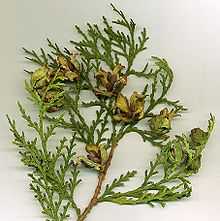Platycladus
| Chinese arborvitae | |
|---|---|
 | |
| Platycladus orientalis Morton Arboretum acc. 168-53#3[1] | |
| Conservation status | |
| Scientific classification | |
| Kingdom: | Plantae |
| Division: | Pinophyta |
| Class: | Pinopsida |
| Order: | Pinales |
| Family: | Cupressaceae |
| Genus: | Platycladus Spach |
| Species: | P. orientalis |
| Binomial name | |
| Platycladus orientalis (L.) Franco[2] | |
| Synonyms[3] | |
| |
Platycladus is a distinct genus of evergreen coniferous tree in the cypress family Cupressaceae, containing only one species, Platycladus orientalis, also known as Chinese arborvitae, biota or oriental thuja. It is native to northwestern China, Korea, and the Russian Far East (Amur + Khabarovsk).[3][4] It is also now naturalised as an introduced species elsewhere in Asia: eastward to Japan; southward to northern India; and westward to northern Iran.
Taxonomy
Although generally accepted as the only member of its genus, it has been suggested that the closely related species Microbiota decussata could be included in Platycladus, but this is not widely followed. Other fairly close relatives are Juniperus and Cupressus, both of these genera being graft-compatible with Platycladus. In older texts, Platycladus was often included in Thuja, which is reflected in one of its common names, "oriental thuja". But it is only distantly related to the genus Thuja. Differences include its distinct cones, wingless seeds, and its almost scentless foliage.
Etymology
The binomial Platycladus means "with broad or flattened shoots". The qualifier orientalis refers to its native habitat in China.[5]
The common name 'arborvitae' is from Latin, 'tree of life', and is based on its association with long life and vitality in Buddhist thought in China. This is probably based on the tree's unchanging evergreen nature in the cold dry climate of northwest China, and its longevity; some of the larger specimens planted around Buddhist temples in China are said to be in excess of 1,000 years old. It is called ce bai (側柏) in Chinese.
Description

It is a small, slow-growing tree, to 15–20 m tall and 0.5 m trunk diameter (exceptionally to 30 m tall and 2 m diameter in very old trees). The foliage forms in flat sprays with scale-like leaves 2–4 mm long. The cones are 15–25 mm long, green ripening brown in about eight months from pollination, and have 6-12 thick scales arranged in opposite pairs. The seeds are 4–6 mm long, with no wing.
Uses
It is used as an ornamental tree, both in its homeland, where it is associated with long life and vitality, and very widely elsewhere in temperate climates. Several cultivars have been selected, of which 'Aurea nana'[6] and 'Elegantissima'[7] have gained the Royal Horticultural Society's Award of Garden Merit.
The wood is used in Buddhist temples, both for construction work, and chipped, for incense burning.
See also
- Chinese herbology 50 fundamental herbs
References
- ↑ Cirrus Digital: Platycladus orientalis Morton Arboretum accession 168-53#3
- ↑ "Platycladus orientalis information from NPGS/GRIN". Retrieved 2008-02-19.
- ↑ 3.0 3.1 Kew World Checklist of Selected Plant Families
- ↑ Flora of China Vol. 4 Page 64 侧柏 ce bai Platycladus orientalis (Linnaeus) Franco, Portugaliae Acta Biol., ser. B, Sist. Vol. "Júlio Henriques". 33. 1949.
- ↑ Harrison, Lorraine (2012). RHS Latin for gardeners. United Kingdom: Mitchell Beazley. p. 224. ISBN 9781845337315.
- ↑ "RHS Plant Selector - Platycladus orientalis 'Aurea Nana'". Retrieved 27 May 2013.
- ↑ "RHS Plant Selector - Platycladus orientalis 'Elegantissima'". Retrieved 27 May 2013.
General references
- Conifer Specialist Group (1998). Platycladus orientalis. 2006. IUCN Red List of Threatened Species. IUCN 2006. www.iucnredlist.org. Retrieved on 6 May 2006.
- Gymnosperm Database - Platycladus orientalis
- Arboretum de Villardebelle - Platycladus cone photos
- Conifers Around the World: Platycladus orientalis - Oriental Arborvitae.
| Wikimedia Commons has media related to Platycladus orientalis. |
